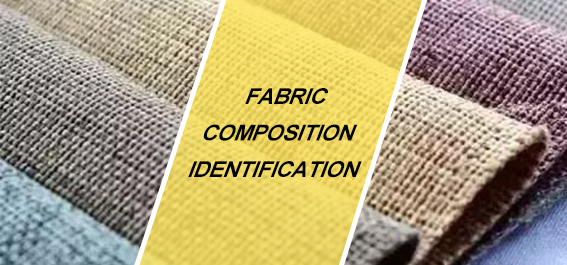The easy way to identify the composition of clothing fabrics is the combustion method. The method is to draw a piece of cloth yarn containing warp yarn and weft yarn at the seam of the garment, ignite it with fire, observe the state of the burning flame, smell the smell of the cloth yarn after burning, and see the residue after burning to judge Whether it is consistent with the fabric component marked on the clothing durability label to distinguish the authenticity of the fabric component.

1.Cotton fiber and hemp fiber
Cotton fiber and hemp fiber Both cotton fiber and hemp fiber ignite immediately after the flame, burning rapidly, the flame is yellow and blue smoke. The difference between the smell of burning and the ash after burning is that cotton burns out the smell of paper and hemp burns out the smell of grass and wood; after burning, cotton has very little powder ash, which is black or gray, and hemp produces a small amount of off-white powder ash.
2.Wool fiber and silk
Wool fiber and silk Mao met with fire and smoked, blistered when burning, the burning speed was slow, and emitted the burning smell of burning hair. After burning, the ash was mostly glossy black spherical particles, which were broken when pressed. The silk shrunk into a mass when it caught fire, and it burned slowly, accompanied by hissing sounds, and gave off a burning smell of hair. After burning, it formed into a black-brown ball-shaped ash, which was broken by hand twisting.
3.Nylon and polyester
Polyamide fiber, which is a scientific name of polyamide fiber, quickly shrinks and melts into a white gel when it is near the flame. It melts and drips in the flame and blisters. There is no flame when burning. It is difficult to continue burning when leaving the flame. It emits a celery smell. Things are not easy to break. Polyester fiber, which is scientifically named polyester fiber, is easy to ignite. It melts and shrinks when it is near the flame. When burning, it emits black smoke while melting, showing a yellow flame with an aromatic smell. After burning, the ash is a dark brown hard block that can be twisted with fingers.
4. Acrylic and polypropylene
Acrylic fiber scientific name polyacrylonitrile fiber, softening and shrinking near fire, black smoke after fire, the flame is white, burns quickly after leaving the flame, exudes the bitter smell of burning meat, after burning, the ash is irregular black hard block, hand twist is fragile . Polypropylene scientific name polypropylene fiber, which melts and shrinks near the flame, is flammable, burns slowly from the fire and emits black smoke, the upper end of the flame is yellow, the lower end is blue, and it emits the smell of petroleum. The ash after burning is a hard round light yellow brown particle, easy to twist broken.
5. Vinylon and Chlorine
Vinylon's scientific name, polyvinyl formal fiber, is not easy to ignite, and the near flame melts and shrinks. There is a little flame at the top when burning. When the fiber is melted into a gel, the flame becomes larger, there is thick black smoke, and it emits a bitter smell. Black remains after burning Bead-shaped particles can be crushed with your fingers. Polyvinyl chloride fiber, a scientific name for chloroprene, is difficult to burn and extinguishes immediately after fire. The flame is yellow with green and white smoke at the lower end. It emits a pungent, spicy and sour taste. After burning, the ashes are dark brown irregular lumps and the fingers are not easy to twist.
6. Spandex and Fluorine
Polyurethane fiber, the scientific name of spandex, burns while melting near the fire. The flame is blue when burning. When it leaves the fire, it continues to burn and emit a special pungent odor. After burning, the ash is soft and fluffy black ash. Fluorocarbon scientific name PTFE fiber, ISO organization called it fluorite fiber, near flame only melted, difficult to ignite, not burned, the edge flame was blue-green carbonized, melted and decomposed, the gas was toxic, the melt was hard round black Beads. Fluorine fiber is commonly used in the textile industry to manufacture high-performance sewing threads.
7.Viscose fiber and copper ammonium fiber
Viscose fiber is flammable, the burning speed is fast, the flame is yellow, and emits the smell of burning paper. After burning, there is little ash, and it is smooth and twisted and light gray or off-white fine powder. Copper ammonium fiber, commonly known as tiger kapok, burns near the flame, the burning speed is fast, the flame is yellow, and it emits ester and acid smell. After burning, there is very little ash, only a small amount of gray black ash.